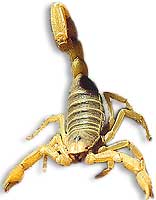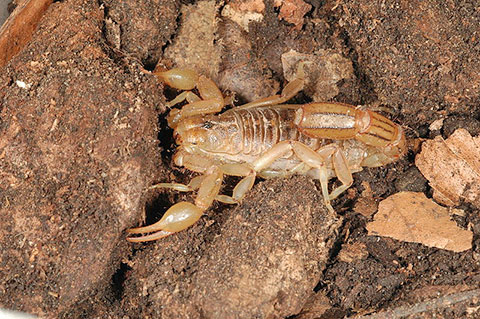This was very intresting text about Scorpions from a webpage called Dessert USA (link up on the page). It is very informative and good so i choose to include it in my blog. Enjoy!
Scorpions
Order: Scorpiones

Hadrurus arizonensis pallidus
These are the largest scorpions found in the United States.
Scorpions: Overview | Scorpion Stings | Prevention
Scorpions have been found in many fossil records, including coal deposits from the Carboniferous Period and in marine Silurian deposits. They are thought to have existed in some form since about 425-450 million years ago. They are believed to have an oceanic origin, with gills and a claw like appendage that enabled them to hold onto rocky shores or seaweed.
Scorpion Venom
Scorpion venom is used to subdue prey and to defend against threats, as well as in the mating process. The composition and action of the venom varies from species to species. The venoms are mixtures of salts, small molecules, peptides, and proteins. The peptides are specialized; some act against invertebrates and some against vertebrates, and some target both. This complex formula results in a neurotoxin which depolarizes the nervous system of the victim.
Scorpions are apparently able to regulate the delivery of the venom in scale to the size of their target. Some scorpions are known to produce a transparent prevenom in addition to the more potent opaque venom which is loaded with additional toxin. The use of the prevenom occurs at the initiation of the threat or opportunity. If the action persists, the opaque venom is released. These abilities enable the scorpion to conserve the venom for use when it is needed most, for larger predators or prey.
Most scorpion stings are not considered life threatening to humans -- the exception is the sting of the bark scorpion, the most venomous in the United States. Most of the scorpions in the U.S. are found in the southwest, preferring the warm, dry climates found in Arizona, California and New Mexico.
Life Cycle
The pedipalps are used in scorpion courtship behavior. The male performs a kind of dance with the female, grabbing her pedipalps with his own and dragging her across the ground until he locates a preferred place to deposit his spermatophore, which is then drawn up into the female's genital pore, near the front on the underside of her abdomen. Some species' courtships include a sexual sting of the female by the male.
Scorpion gestation periods vary from several months to a year and a half, depending on the species. Each brood will consist of about 24-35 young. They are viviparious - the young develop as embryos in the female's ovariuterus. The young scorpions are born two at at time, climbing onto their mother's back to be carried there until their first molt in about two weeks, when they will be large and strong enough to take care of themselves.
Scorpions do not metamorphasize as they grow, changing only in size and sometimes to a deeper color with each molt. Typically five or six molts over two to six years are required for the scorpion to reach maturity. The molting is accomplished by a split in the outer covering through which the scorpion must crawl in order to grow.
Scorpion lifespans range from three to five years, though some species are thought to live 10-15 years. Some kinds of scorpions show more sophisticated social behaviors, like colonial burrowing, and living in familial groups that may share burrows and food.
Description
The scorpion's body has two parts, a cephalothorax which contains the prosoma, or head; and the abdomen. The cephalothorax is covered by the carapace, a hard bony or chitinous outer covering. The carapace usually suports a pair of median eyes at the top center. Two to five pairs of lateral eyes are found at the front corners of the carapace, though a few cave and montane forest litter-dwelling scorpions are eyeless. Chelicerae, the scorpion's mouthparts, and a pair of pedipalps, or claws used for prey capture and mating complete the head anatomy. The pedipalps are covered with trichobothria, sensory setae, that sense air-borne vibrations.
The abdomen is made up of the mesosoma, the main body, and the metasoma, the tail. The mesosoma, protected by bony armour, contains the lungs, digestive organs and sexual organs, as well as bearing 4 pairs of walking legs and the pectines. The tips of the legs have small organs that detect vibrations in the ground. The pectines are feathery sensory organs which hang beneath the abdomen and trail on the ground. They are coated by chemosensors that provide detection of minute chemical signals that are thought to alert the scorpions to the approach of prey and also to be of use in mating behavior. The respiratory structure, known as "book lungs," are spiracles that open into the scorpion's body. The surfaces of the legs, pedipalps, and body are also covered with thicker hairs that are sensitive to direct touch.
The metasoma curves up and ends in the telson, which bears the bulbous vesicle containing the venom glands and a sharp, curved aculeus which delivers the venom.
Most species of scorpions reach adulthood at a length of between 2 and 3 inches.The longest scorpion in the world is probably the African Scorpion (Hadogenes troglodytes) which grows to over 8 inches in length. In the U.S., members of the genus Hadrurus (giant desert hairy scorpions) are probably the largest, growing to a length of about 5 inches.
Common Questions:
Where are scorpions found?
What are the symptoms of a scorpion sting?
Which scorpion is the most venomous in the United States?
Characteristics Shared by All Scorpions
Scorpions have a chitinous exoskeleton and a segmented body with four pairs of jointed legs, putting them in the phylum Arthropoda and the class Arachnida. They share their class with spiders, mites, ticks and harvestmen. The order Scorpiones numbers over 1,500 species, with over 70 species in the United States alone.
- Crablike appearance
- Four pairs of legs
- A pair of pincers
- Long, segmented tail that curls up with a stinger on the end
Three Most Common Scorpions Found in the Southwest

Captive Hairy Scorpion, 2003, Photo by Fritz Geller-Grimm. Wikimedia Commons.
Arizona Hairy Scorpion - Hadrurus arizonesis
- Range: Southern California, Arizona
- 5-7" in length
- Venomous, but not very potent. An allergic reaction to a bite could be very dangerous.
- Yellow in color with darker coloring on top of body
- Pair of pincers
- 4 pairs of legs
- Tail with stinger
- Small brown hairs cover body

Bark Scorpion, 2008, Photo by Musides. Wikimedia.
Bark Scorpion - Centruroides exilicauda (formerly C. sculpturatus)
- Range: Arizona, Southeastern California, Southwestern New Mexico, Mexico (Baja California and Sonora)
- Venomous and dangerous to people. The bark scorpion is the most venomous scorpion in North America.
- Light brown in color
- Up to 3" in length
- Thin tail about 1/16 wide
- Pair of pincers
- 4 pairs of legs
- Tail with stinger

Stripe-tailed Scorpion, 2008, Acrocynus, Wikimedia.
Stripe-tailed Scorpion (aka Devil Scorpion) - Vaejovis spinigerus
- Range: Southern California, Arizona
- Venomous, but not considered dangerous.
- 2.5" in length
- Light brown in color
- The body has brownish stripes on the upper side
- Pair of pincers
- 4 pairs of legs
- Tail with stinger
Range & Habitat
Though most prolific and diverse in warm habitat, scorpions have adapted to a wide range of environments, including plains and savannahs, deciduous forests, mountainous pine forests, rain forests and caves. Scorpions have been found at elevations of over 12,000 feet in the Andes Mountains in South America and in the Himalayas of Asia, as well as the Alps. In snowy areas, they hibernate during the cold months of the year. In drought areas they may aestivate (pass the summer in a dormant or torpid state).
About 90 species are found in the U.S. All but four of these naturally occur west of the Mississippi River and are abundant in semi-arid regions. The highest concentration of scorpions are found in Arizona, California, New Mexico and Texas.
Behavior
Scorpions are nocturnal and hide during the day. Some scorpions species will hide under rocks, logs and in cracks, other species will dig and hide in burrows.
Lean more about scorpion control and prevention!
Diet/Food
Scorpions are predatory. They often ambush their prey, lying in wait as they sense its approach. They consume all types of insects, spiders, centipedes and other scorpions. Larger scorpions may feed on vertebrates, such as smaller lizards, snakes, and mice if they are able to subdue them. They capture their prey with their pedipalps, paralyzing them with their venom as well if necessary. The immobilized prey is then subjected to an acid spray that dissolves the tissues, allowing the scorpion to suck up the remains.

As well as being predators, scorpions are also prey. Many types of creatures, such as centipedes, tarantulas, insectivorous lizards, birds (especially owls), and mammals, including shrews, grasshopper mice, and bats hunt scorpions for food.
Interesting Scorpion Facts
- The most dangerous scorpion is the "Deathstalker" or Leiurus quinquestriatus which is prevalent in North Africa and the Middle East.
- Scorpions glow when exposed to an unltraviolet light, like a blacklight, due to flourescent chemicals in the cuticle.
- During courtship the scorpions grasp the pedipalps (pincers) and perform a dance called the "promenade à deux."
- Scorpions don't bite, they "sting."
- There are more than 1,500 species of scorpions worldwide.
- California and Arizona have the greatest diversity of scorpions with about 60 species.
More information on control and removal of scorpions
Scorpions: Overview | Scorpion Stings | Prevention
Animals - Wildlife | Wildflowers-Plants | Minerals - Geology | Desert People
The information provided on this web site and by this web site through content provided by Authors or third party providers, and in other sources to which it refers, is PROVIDED FOR INFORMATIONAL PURPOSES ONLY and should not be used to diagnose or treat a health problem or disease.
Information provided at and by DesertUSA is NOT A SUBSTITUTE FOR PROFESSIONAL MEDICAL CARE. If you have a medical concern, or suspect you have a health problem you should consult your primary doctor or specialist.
If you cannot agree to this Health and Medical Disclaimer, you are not permitted to use this web site and should exit immediately.
Read more: https://www.desertusa.com/insects/scorpion.html#ixzz6iWEG7f5t


No comments:
Post a Comment